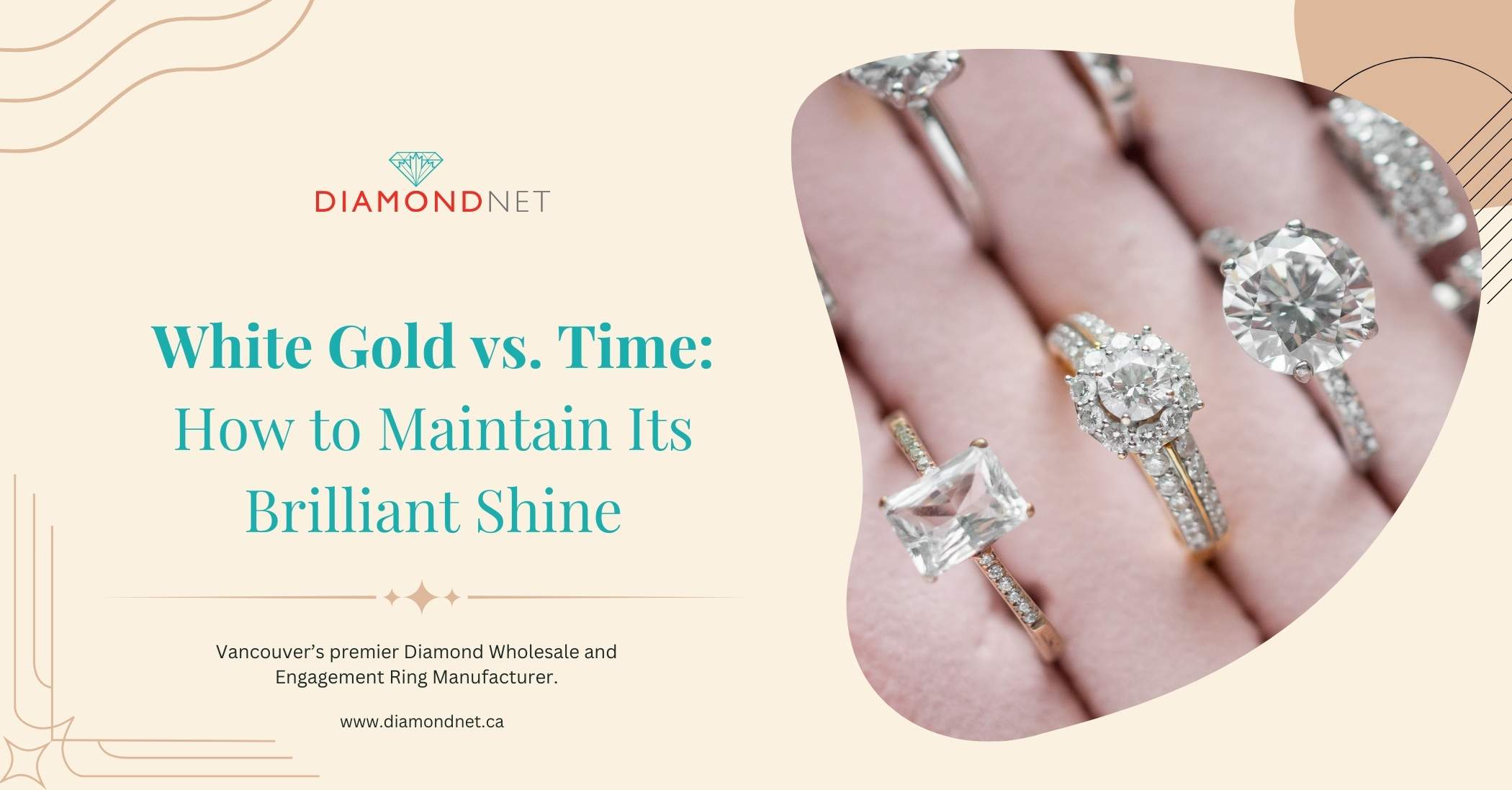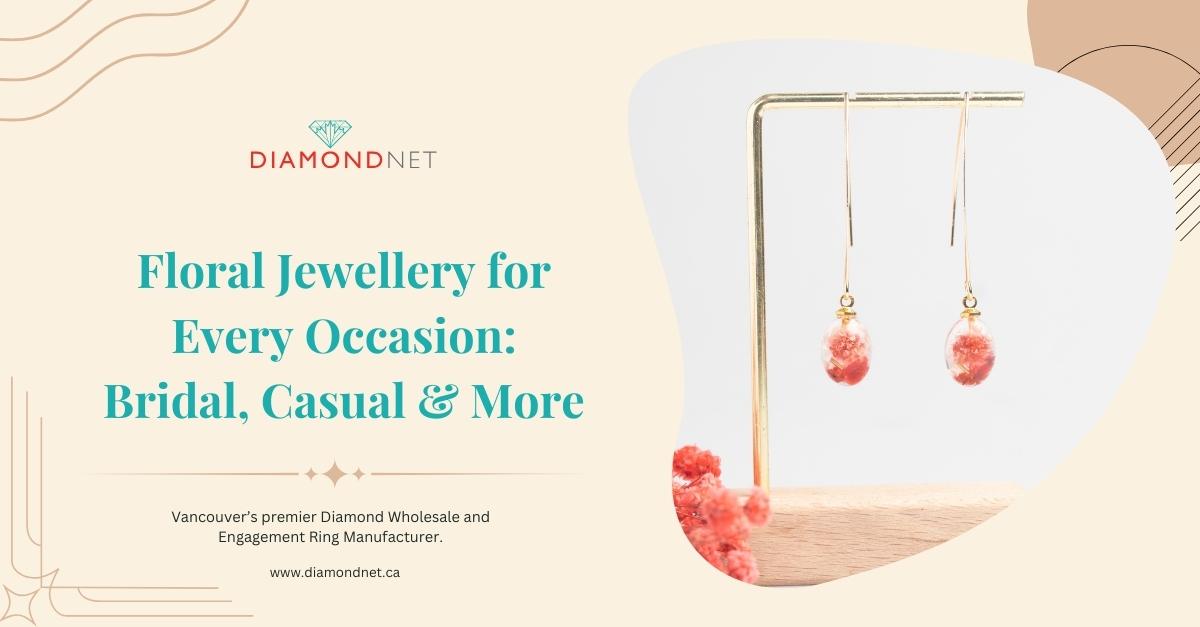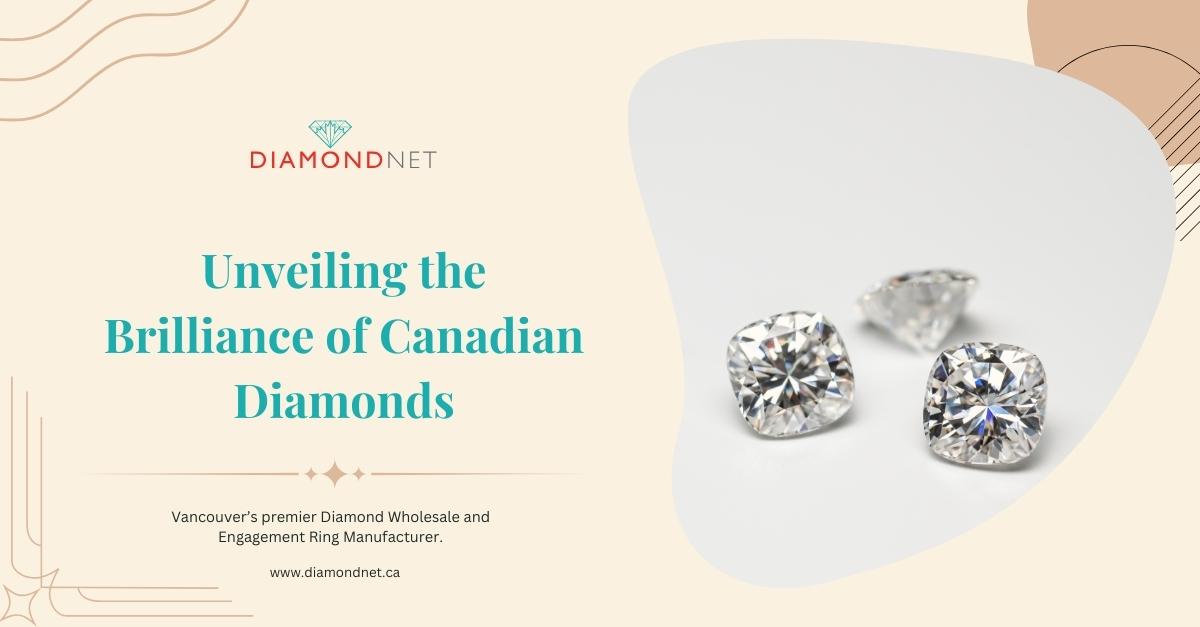White gold is a popular choice for jewellery in Canada, admired for its sleek, silvery appearance. However, over time, it can develop a yellowish tint.
This happens because white gold is an alloy made by mixing yellow gold with metals like nickel, palladium, or silver. To achieve its signature bright white finish, it is coated with rhodium plating. As this plating wears off, the underlying alloy becomes visible, causing the colour to shift.
Understanding why white gold turns yellow and how to maintain it is essential for preserving its beauty. In this guide, we’ll explore the reasons behind this change, share maintenance tips, and explain how professional cleaning and rhodium re-plating can help restore white gold jewellery to its original shine.
What is white gold made of?
White gold is not naturally white—it is created by alloying yellow gold with white metals such as nickel, palladium, or silver. This combination enhances durability while giving white gold its distinct colour. The karat of white gold indicates the proportion of pure gold in the alloy, with 14K and 18K being the most common options.
However, even with these metals, white gold does not achieve a true bright white finish on its own. To enhance its appearance, a thin layer of rhodium—a rare and highly reflective metal—is applied as a coating. This rhodium plating not only gives white gold its signature shine but also provides protection against scratches and wear.
Over time, rhodium plating can wear off due to friction, exposure to chemicals, and daily wear, revealing the slightly yellowish alloy underneath. This gradual colour change is a normal process, which is why regular maintenance, including re-plating, is essential for keeping white gold jewellery looking its best.
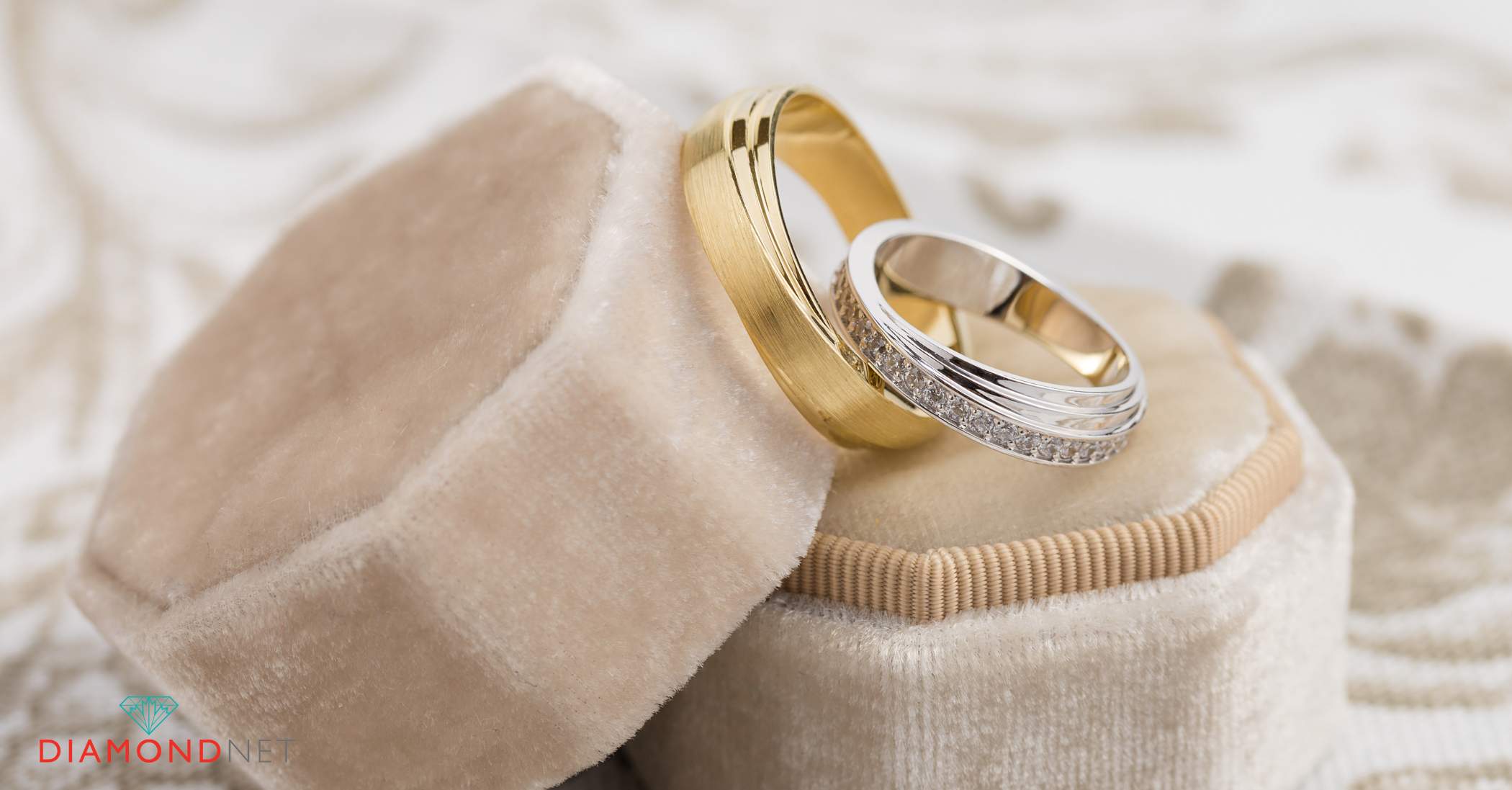
Why does white gold change colour?
If you’ve ever wondered, Why does white gold turn yellow? you’re not alone. This common issue occurs due to the natural wear of rhodium plating, which gives white gold its bright, silvery appearance.
The Role of Rhodium Plating
White gold is made by alloying yellow gold with metals like nickel, palladium, or silver. While this mixture lightens the colour of gold and enhances durability, it does not create a pure white finish. To achieve the bright white appearance, white gold is coated with a thin layer of rhodium—a rare, hypoallergenic, and highly reflective metal.
Does Rhodium plating wear off over time?
Yes, rhodium plating is not permanent. Over time, the protective layer wears away due to various factors:
- Friction and Abrasion – Daily wear, especially on rings and bracelets, exposes white gold to constant friction. Activities like typing, washing dishes, or wearing jewellery against other pieces can gradually wear down the rhodium layer.
- Exposure to Chemicals – Household cleaners, lotions, perfumes, and chlorine from swimming pools can accelerate the breakdown of rhodium plating, causing it to fade more quickly.
- Skin pH Levels – Individual skin chemistry can also play a role. Some people’s skin acidity causes rhodium to wear off faster, leading to a quicker colour change.
The Science Behind the Colour Change
As the rhodium plating wears away, the underlying gold alloy becomes visible. Since white gold is still primarily made of yellow gold, the exposed alloy may have a slight yellowish tint. The rate of this colour change depends on factors like the thickness of the rhodium layer, how often the jewellery is worn, and the environmental conditions it is exposed to.
Is this normal?
Absolutely. Rhodium plating enhances the appearance of white gold, but it is not meant to last forever. The good news is that this process is reversible—professional rhodium re-plating can restore your jewellery’s bright white finish, making it look as good as new.
What is the best way to maintain white gold jewellery?
White gold requires proper care to maintain its polished appearance and prevent discolouration. Regular maintenance helps slow down rhodium wear and keeps your jewellery looking its best. For more tips, read DiamondNet’s guide on cleaning and caring for your jewellery.
Preventative Care Tips
- Remove Jewellery During High-Impact Activities – Take off your white gold jewellery before cleaning, gardening, swimming, or exercising to minimize friction and exposure to harsh chemicals.
- Avoid Contact with Lotions and Perfumes – Apply beauty products before wearing jewellery to prevent chemical reactions that may damage the rhodium plating.
- Store Jewellery Properly – Keep white gold pieces in a soft pouch or lined jewellery box to prevent scratches and contact with other metals.
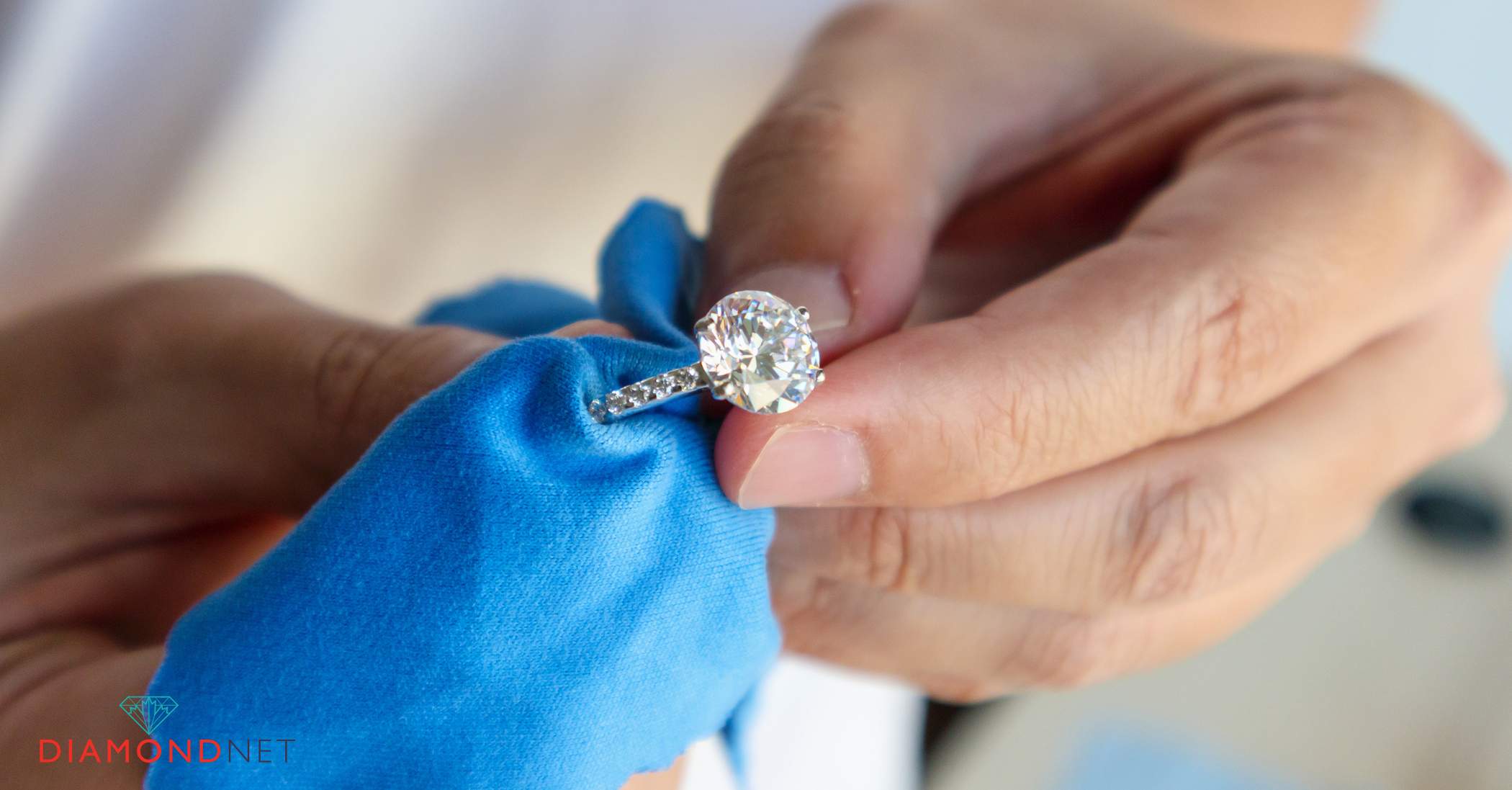
How to Clean and Care for Your Jewellery
Regular cleaning helps maintain the shine and beauty of white gold jewellery. Follow these simple steps for safe at-home care:
- Use Mild Soap and Water – Mix a few drops of mild soap with warm water. Soak the jewellery for 10–15 minutes to loosen dirt and buildup.
- Gently Clean with a Soft Brush – Use a soft-bristle toothbrush to clean intricate details. Avoid abrasive scrubbing, as it can wear down the rhodium plating.
- Rinse and Dry Thoroughly – Rinse with clean water to remove soap residue, then pat dry with a soft, lint-free cloth.
- Avoid Abrasive Materials – Avoid polishing cloths with harsh chemicals or abrasives that can damage the plating.
By following these care tips, you can preserve the beauty of your white gold jewellery for years to come.
Restoring Your White Gold’s Shine: Rhodium Re-Plating
Over time, even well-maintained white gold jewellery may lose its bright white finish as the rhodium plating wears off. If your jewellery has developed a yellowish tint, don’t worry—this is a natural process that can be easily reversed. Professional rhodium plating services in Canada provide a reliable solution to restore your white gold’s original brilliance. Here’s what you need to know about the process.
How often should you re-plate white gold?
Jewellery owners often ask, How often should white gold be re-plated? The answer depends on several factors, including how frequently the piece is worn and the conditions it is exposed to.
- Daily Wear – Rings and bracelets experience more friction and contact with surfaces, typically requiring re-plating every 12 to 18 months.
- Occasional Wear – Necklaces, earrings, or pieces worn less frequently may only need re-plating every 2 to 3 years.
- Lifestyle Factors – Exposure to chemicals, lotions, or frequent abrasion can accelerate rhodium wear, requiring more frequent maintenance.
Regularly inspecting your jewellery for dullness or yellowing can help determine when re-plating is necessary.
What does Rhodium re-plating involve?
Rhodium re-plating is a professional process that restores the shine and durability of white gold jewellery. The steps typically include:
- Cleaning – The jewellery is thoroughly cleaned to remove dirt, oils, and any residue that could interfere with the plating process.
- Polishing – The surface is polished to smooth out scratches and prepare it for the new rhodium layer.
- Rhodium Application – A thin layer of rhodium is electroplated onto the jewellery, restoring its bright, reflective finish.
- Final Inspection – The piece is carefully inspected to ensure an even coating and flawless appearance.
How much does Rhodium re-plating cost in Canada?
The cost of rhodium re-plating depends on the size and complexity of the jewellery piece. Generally, prices range between $100 and $250 per item. While re-plating is an additional expense, it is a worthwhile investment to keep your white gold jewellery looking as good as new.
Choosing Professional Restoration Services
For expert re-plating and jewellery maintenance, opt for trusted jewellers like DiamondNet. Our professional cleaning and rhodium re-plating services restore your white gold pieces to their original brilliance, ensuring they remain beautiful over time.
In addition to restoration, we offer consultations to help you select and maintain white gold jewellery. Whether you need expert care tips or guidance in choosing elegant, long-lasting pieces, our team is here to assist you.
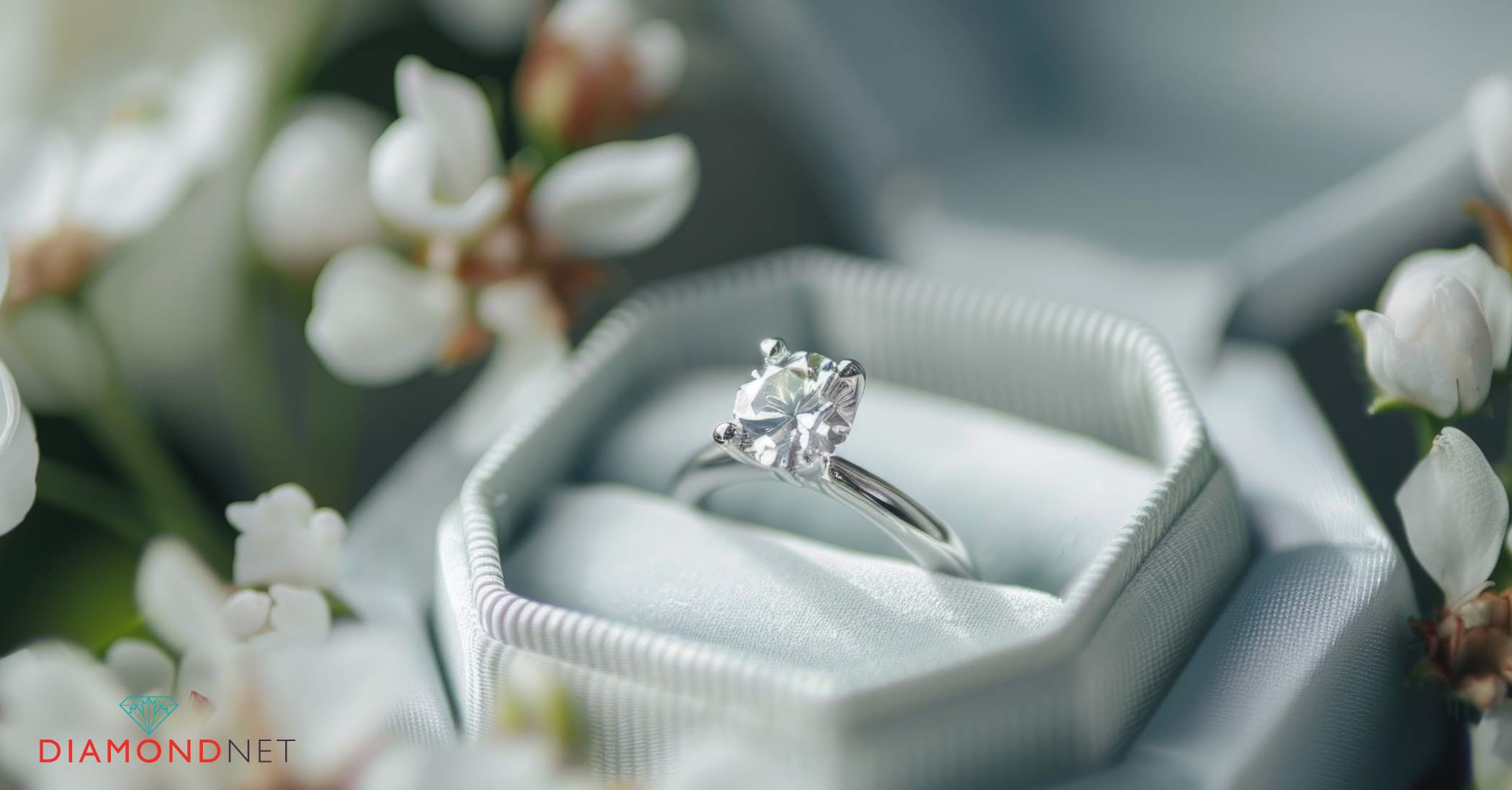
Alternative Metal Options: Comparing White Gold and Platinum
White gold is a popular choice for jewellery, but it’s not the only option. If you’ve ever wondered, “Is white gold better than platinum?” or “white gold vs. platinum: which is better?“ this comparison will help you make an informed decision.
Platinum: Durable and Maintenance-Free, but Higher Cost
Platinum is a naturally white metal that does not require rhodium plating, unlike white gold. It maintains its bright white appearance without the risk of yellowing over time.
Platinum is also highly durable and hypoallergenic, making it an excellent option for those with sensitive skin. However, it comes at a higher cost. Platinum is heavier and denser than white gold, which contributes to its price and luxurious feel.
Which is Better: White Gold or Platinum?
The best choice depends on your priorities:
- Choose platinum if you prefer a durable, low-maintenance metal with a naturally white colour.
- Opt for white gold if you love its bright shine and are willing to invest in regular maintenance, such as rhodium re-plating, to keep it looking its best.
Both metals have their advantages, so the right choice depends on your lifestyle, budget, and aesthetic preferences. If you’re still unsure, DiamondNet’s expert consultations can help you decide which metal is best for your next jewellery piece.
Other White Metals: Palladium and More
Palladium is another white metal commonly used in jewellery. Like platinum, it is naturally white and does not require plating. It is also more affordable than platinum, though it may not offer the same level of durability.
Other metals, such as silver, can also be used to create white-coloured jewellery, but they are generally less durable and more prone to tarnishing than platinum or palladium.
Conclusion
White gold is a beautiful and elegant choice for jewellery, but like any precious metal, it requires proper care to maintain its bright, lustrous appearance. Understanding how white gold is made, why it changes colour, and how to care for it will help preserve its beauty for years to come.
Regular cleaning, avoiding harsh chemicals, and periodic rhodium re-plating can keep your white gold jewellery looking as pristine as the day you bought it.
When choosing between white gold and other metals, consider your lifestyle, maintenance preferences, and budget. By making informed decisions and following the right care routine, you can ensure your white gold jewellery remains a timeless part of your collection.
